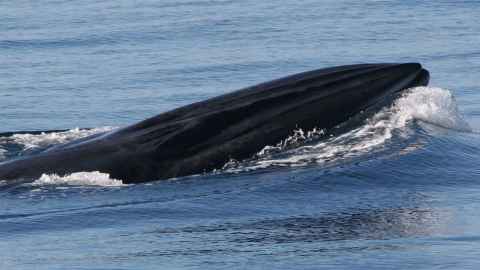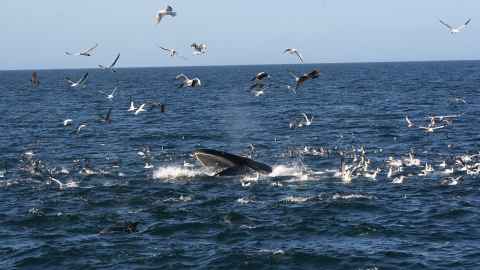Auckland’s endangered whales may be moving further afield
15 August 2025
The most common whales in the inner Hauraki Gulf, Bryde's whales, could increasingly be further out as prey shift due to climate.

The whales most often sighted by Aucklanders, Bryde’s whales, may be spending more time outside of a traditional favourite spot, the inner Hauraki Gulf.
They may be going further afield in search of prey such as zooplankton and small fish like anchovies as marine heatwaves disrupt Gulf ecosystems, University of Auckland scientists suggest.
A recent study led by PhD student Annabelle Cranswick estimates a population of about 160 critically endangered Bryde’s whales live off the northeastern coast of New Zealand from Coromandel to the Bay of Islands, and sometimes off North Cape, based on sightings over the decade to 2023.
Overall, the population seems to be stable based on sightings largely collected by the Auckland Whale and Dolphin Safari boat.
But an anticipated bounce in numbers hasn’t occurred – or at least it hasn’t been recorded.
Since ships voluntarily slowed down in the Gulf from 2013 deaths from collisions seem to have been eliminated meaning about 25 whales that would have died from ship-strike should have featured in the new population estimate. Females can give birth to a calf every two years, so that also should have helped the population to expand.
“Marine heatwaves altering ecosystems in the Gulf may be pushing the whales into the less frequently monitored outer Gulf,” says Cranswick. “Future research will need to focus on the broader northeastern coastline where these whales are increasingly seen.”

The research team included the Far Out Ocean Research Collective whose recent work in northern and offshore waters continue to expand the future survey area.
"Given the wide geographic distribution of marine megafauna such as Bryde’s whales, collaboration between research organisations and mana whenua is crucial to maximise conservation outputs," said Jochen Zaeschmar from Far Out.
Professor Rochelle Constantine, the senior author of the study, said: “This shows just how hard it can be to monitor a critically endangered species during a time of rapid environmental change.”
Bryde’s is pronounced `Broodus' – the whale is named after a Norwegian whaler, Johan Bryde.

Media contact
Paul Panckhurst | Science media adviser
M: 022 032 8475
E: paul.panckhurst@auckland.ac.nz